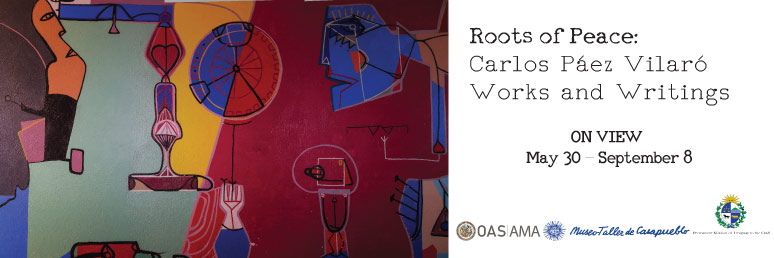Roots of Peace: Carlos Páez Vilaró Works and Writings
May 30 – September 8, 2019
HOURS
Tuesday-Sunday 10AM-5PM
LOCATION
OAS AMA | Art Museum of the Americas
201 18th Street NW
Washington, DC 20006
ADMISSION
Free
The OAS AMA | Art Museum of the Americas and the Permanent Mission of Uruguay to the OAS in collaboration with Museo Taller de Casapueblo present Roots of Peace: Carlos Páez Vilaró Works and Writings, a retrospective exhibition of Uruguayan painter, potter, sculptor, muralist, writer, composer and builder Carlos Páez Vilaró (Montevideo, 1 November 1923 – Punta Ballena, 24 February 2014). The exhibition includes paintings, books, archival materials, and insights into the history of the Roots of Peace mural, painted in 1960, and restored in 1975, 2001-2002, and 2019 The colorful mural—at 530 feet one of the longest murals in the world—will open for public tours for the first time since it was painted in 1960, on the occasion of this exhibition.
Roots of Peace, which is nearly as long as the nearby Washington Monument is high, runs underground the OAS campus next to the National Mall and serves as a daily reminder to OAS diplomats and staff of their mission to ensure peace and harmony throughout the Americas. It was conceived in ten large tonal and thematic areas, without clear demarcation, suggesting the spiritual unity that bonds the peoples of the Americas without suppressing unique differences.
The mural’s themes are: technical cooperation, racial tolerance, mutual assistance and closely knit markets, physical health, common ideals, preservation of folklore, cultural exchange and artistic encouragement, use of natural resources and industrial development, child-welfare services and the eradication of ignorance, and respect for liberties. The aim to achieve the fruits of peace is repeatedly symbolized by the image of a fish, the dominant note in the mural. It was restored by Spanish artist Roberto Arce between 2001 and 2002, who recovered the lines and colors of the work that had been repainted by Páez Vilaró in 1975. Arce has again been commissioned to restore the mural to its original brilliance, in 2019.
The exhibition includes more than two dozen paintings of the collection of the Museo Taller de Casapueblo, Uruguay, recognized as the foremost collection of works of Páez Vilaró. Exhibition visitors will also be able to browse physical copies of Páez Vilaró’s books and writings.
Vilaró, abstract artist, painter, potter, sculptor, muralist, writer, composer and architect, was invited to exhibit some of his work by the Director of the Modern Art Museum of Paris, Jean Cassou, in 1956. In that same year he traveled to Dakar, Senegal to continue his research on African aesthetics that he has already initiated in Brazil. He remained active in European and African culture throughout most of his life. He continued to create murals and sculptures for various government offices, corporate headquarters, private homes, and other buildings. Casapueblo, a building near Punta del Este, is one of his best-known creations. Vilaró remained close with numerous friends from his days in Paris in the late 1950s, particularly Brigitte Bardot and Pablo Picasso, and in 1967, established Dahlia, a film production company with the help of European industrialists Gerard Leclery and Gunther Sachs. He traveled in numerous West African nations to make a documentary, Batouk, with director Jean-Jacques Manigot and poet Aimé Césaire. Vilaró created murals in Argentina, Brazil, Chad, Chile, Gabon, the United States, and in his native Uruguay, as well as a scattering of works elsewhere in Africa and in the Polynesian islands. He also designed a non-denominational chapel in Buenos Aires; he considered the San Isidro chapel his greatest work. In his last years the artist divided his time between Casapueblo and Bengala, his Tigre residence. Páez Vilaró died on February 24, 2014 at the age of 90 at his home Casapueblo, in Punta Ballena, Maldonado, Uruguay.
The AMA serves as the principal instrument of cultural diplomacy of the OAS. AMA’s mission is founded on the notion that the arts are transformative for individuals and communities. This guiding principle promotes the core values of the OAS by providing a space for cultural expression, creativity, innovation, dialog, and learning, while highlighting themes such as democracy, development, human rights, justice, freedom of expression, and innovation. AMA’s work draws on contemporary art to showcase a constructive vision of the future of the Americas via local and hemispheric cultural exchange.
Accessibility: AMA’s first floor is wheelchair accessible by appointment, with a ramp that can be installed at the back entrance to the museum. There is a gravel pathway leading to the back entrance. There is one half-step leading from the first room into the first-floor galleries. There is a flight of winding stairs leading to the museum’s second floor. Restrooms are located on the second floor. For more information on accessibility, or to make an appointment to visit, please contact 202 370 0147 or artmus@oas.org


